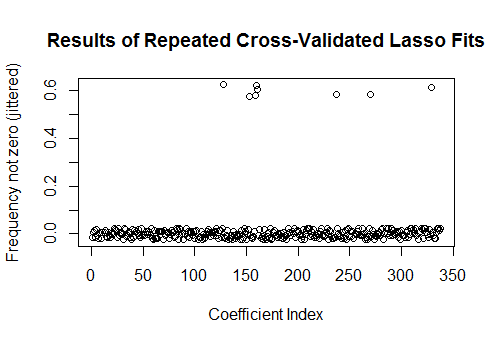I don't think you have made a mistake in the code. This is a matter of interpreting the output.
The Lasso doesn't indicate which individual regressors are "more predictive" than others. It simply has a built-in tendency to estimate coefficients as zero. The larger the penalty coefficient $\log(\lambda)$ is, the greater is that tendency.
Your cross-validation plot shows that as more and more coefficients are forced to zero, the model does a better and better job of predicting subsets of values that have been randomly removed from the dataset. When the best cross-validated prediction errors (measured as the "Binomial Deviance" here) are achieved when all coefficients are zero, you should suspect that no linear combination of any subset of the regressors may be useful for predicting the outcomes.
You can verify this by generating random responses that are independent of all the regressors and applying your fitting procedure to them. Here's a quick way to emulate your dataset:
n <- 570
k <- 338
set.seed(17)
X <- data.frame(matrix(floor(runif(n*(k+1), 0, 2)), nrow=n,
dimnames=list(1:n, c("y", paste0("x", 1:k)))))
The data frame X has one random binary column named "y" and 338 other binary columns (whose names don't matter). I used your approach to regress "y" against those variables, but--just to be careful--I made sure the response vector y and model matrix x match up (which they might not do in case there are any missing values in the data):
f <- y ~ . - 1 # cv.glmnet will include its own intercept
M <- model.frame(f, X)
x <- model.matrix(f, M)
y <- model.extract(M, "response")
fit <- cv.glmnet(x, y, family="binomial")
The result is remarkably like yours:
plot(fit)

Indeed, with these completely random data the Lasso still returns nine nonzero coefficient estimates (even though we know, by construction, that the correct values are all zero). But we shouldn't expect perfection. Moreover, because the fitting is based on randomly removing subsets of the data for cross-validation, you typically won't get the same output from one run to the next. In this example, a second call to cv.glmnet produces a fit with only one nonzero coefficient. For this reason, if you have the time, it's always a good idea to re-run the fitting procedure several times and keep track of which coefficient estimates are consistently nonzero. For these data--with hundreds of regressors--this will take a couple of minutes to repeat nine more times.
sim <- cbind(as.numeric(coef(fit)),
replicate(9, as.numeric(coef(cv.glmnet(x, y, family="binomial")))))
plot(1:k, rowMeans(sim[-1,] != 0) + runif(k, -0.025, 0.025),
xlab="Coefficient Index", ylab="Frequency not zero (jittered)",
main="Results of Repeated Cross-Validated Lasso Fits")

Eight of these regressors have nonzero estimates in about half of the fits; the rest of them never have nonzero estimates. This shows to what extent the Lasso will still include nonzero coefficient estimates even when the coefficients themselves are truly zero.




